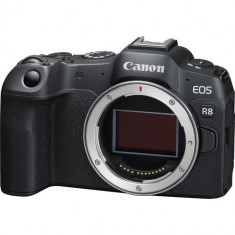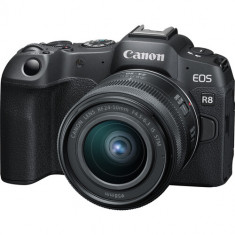Mirrorless
- 78 itemsFilters
Brand
-
28
-
18
-
32
Availability
-
47
-
78
-
78
Lens Mount
-
1
-
1
-
4
-
9
Monitor Size
-
8
-
4
-
11
-
11
-
2
Camera Format
-
36
-
18
Recording Modes
-
37
Pixels
-
5
-
6
-
8
-
12
-
4
-
6
Sensor Type
-
7
Nikon Z 6II Mirrorless Digital Camera Body Only
SKU #103059 Model 1659Key Features
- 24.5MP FX-Format BSI CMOS Sensor
- Dual EXPEED 6 Image Processors
- UHD 4K30 Video; N-Log & 10-Bit HDMI Out
- 14 fps Cont. Shooting, ISO 100-51200
Nikon Z 6II Mirrorless Digital Camera with FTZ II Adapter
SKU #NIZ6IILKSS1 Model 1659Key Features
- 24.5MP FX-Format BSI CMOS Sensor
- Dual EXPEED 6 Image Processors
- UHD 4K30 Video; N-Log & 10-Bit HDMI Out
- 14 fps Cont. Shooting, ISO 100-51200
Canon EOS R8 Mirrorless Camera
SKU #105850 Model 5803C002 UPC #013803351354Key Features
- 24.2MP Full-Frame CMOS Sensor
- 4K60p 10-Bit Internal Video, Canon Log 3
- 3.0" 1.62m-Dot Vari-Angle Touchscreen
- 2.36m-Dot OLED Electronic Viewfinder
- 40 fps Electronic Shutter
- Dual Pixel CMOS AF II

Canon EOS R8 Mirrorless Camera Body With Canon RF 50mm f/1.8 STM Lens
SKU #105850AO1 Model 5803C002 UPC #013803351354Key Features
- 24.2MP Full-Frame CMOS Sensor
- 4K60p 10-Bit Internal Video, Canon Log 3
- 3.0" 1.62m-Dot Vari-Angle Touchscreen
- 2.36m-Dot OLED Electronic Viewfinder
- 40 fps Electronic Shutter
- Dual Pixel CMOS AF II

Canon EOS R8 Mirrorless Camera with RF 24-50mm f/4.5-6.3 IS STM Lens
SKU #105850AO2 Model 5803C002 UPC #013803351354Key Features
- 24.2MP Full-Frame CMOS Sensor
- 4K60p 10-Bit Internal Video, Canon Log 3
- 3.0" 1.62m-Dot Vari-Angle Touchscreen
- 2.36m-Dot OLED Electronic Viewfinder
- 40 fps Electronic Shutter
- Dual Pixel CMOS AF II

Nikon Z 6 Mirrorless Digital Camera Body with Adapter
SKU #102037 Model 1595 UPC #018208015955Key Features
- 24.5MP FX-Format BSI CMOS Sensor
- EXPEED 6 Image Processing Engine
- 273-Point Phase-Detect AF System
- UHD 4K30 Video; N-Log & 10-Bit HDMI Out
Nikon Z 6 Mirrorless Digital Camera with 24-70mm Lens
SKU #102037 Model 1595 UPC #018208015955Key Features
- 24.5MP FX-Format BSI CMOS Sensor
- EXPEED 6 Image Processing Engine
- 273-Point Phase-Detect AF System
- UHD 4K30 Video; N-Log & 10-Bit HDMI Out
Nikon Z8 Mirrorless Camera with 24-120mm f/4 Lens
SKU #103072S1 Model 1695Key Features
- 45.7MP FX-Format Stacked CMOS Sensor
- Lightweight Design, 30% Smaller than Z9
- 8K30p and 4K120p Video, 10-Bit Internal
- 8.3K 60p N-RAW, 4.1K 60p ProRes RAW
Canon EOS M50 Mark II Mirrorless Digital Camera with 15-45mm Lens (Black)
SKU #105840 Model 4728C006 UPC #013803335477Key Features
- 24.1MP APS-C CMOS Sensor
- DIGIC 8 Image Processor
- Dual Pixel CMOS AF with Eye Detect AF
- UHD 4K and HD 720p120 Video Recording
Sony Alpha a1 Mirrorless Digital Camera (Body Only)
SKU #000726 Model ILCE-1/BKey Features
- 50.1MP Full-Frame Exmor R BSI CMOS Sensor
- BIONZ XR Image Processor
- Up to 30 fps Shooting, ISO 50-102400
- 8K 30p and 4K 120p Video in 10-Bit
- 9.44m-Dot EVF with 240 fps Refresh Rate
- 759-Point Fast Hybrid AF
- 5-Axis SteadyShot Image Stabilization
- Dual Drive Mech. Shutter, 1/400 Sec Sync
- 5 GHz Wi-Fi, 1000BASE-T Ethernet
- Dual CFexpress Type A/SD Card Slots
Mirrorless
A mirrorless camera is a digital interchangeable lens camera. Unlike a DLSR, a mirrorless camera lacks a swinging mirror and optical viewfinder. Instead, the light passing through the lens hits the sensor directly, transmits the preview image to an electronic viewfinder (EVF) or the main LCD screen. This allows for mirrorless cameras to be significantly smaller and lighter than DLSRs, among other things.
Mirrorless Cameras
1) What is a mirrorless camera?
A mirrorless camera is a digital interchangeable lens camera. Unlike a DLSR, a mirrorless camera lacks a swinging mirror and optical viewfinder. Instead, the light passing through the lens hits the sensor directly, transmits the preview image to an electronic viewfinder (EVF) or the main LCD screen. This allows for mirrorless cameras to be significantly smaller and lighter than DLSRs, among other things.
2) What does ISO mean?
Photographically, ISO stands for the level of sensitivity the camera’s sensor has to light. The higher the ISO number, the more sensitive the sensor and the brighter the image. ISO is an adjustable setting and reaches much higher than it ever did. However, very high ISO settings can sometimes cause grain or “noise” in the image.
When a camera is said to be “very good in low light” it means that there is little to no noise in the higher ISO values.
3) What is a megapixel?
A camera’s sensor is comprised of millions of individual pixels (for “picture element”). Each pixel works individually to capture a tiny amount of light and color, which then gets combined to form the final image. One million of these pixels equals one megapixel. The number of megapixels determines the resolution of the image, and in turn how large the image can be printed or how much it can be cropped. The more megapixels, the larger your prints can be.











